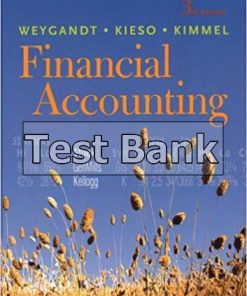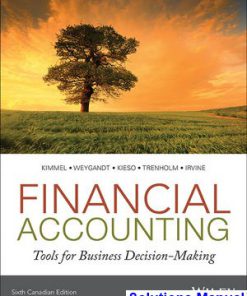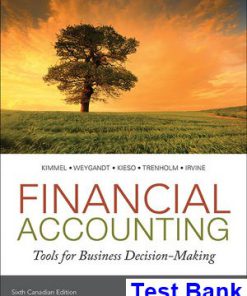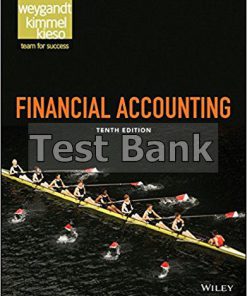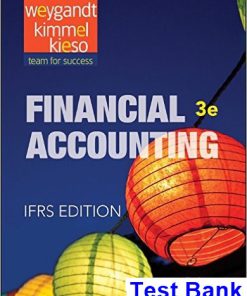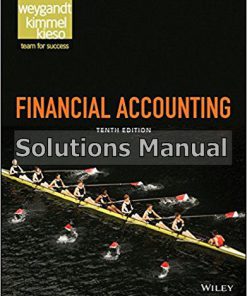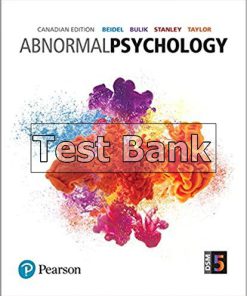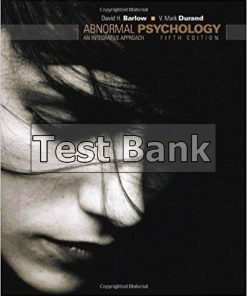Financial Accounting Standalone book 9th Edition Weygandt Test Bank
$26.50$50.00 (-47%)
Financial Accounting Standalone book 9th Edition Weygandt Test Bank.
You may also like
Financial Accounting Standalone book 9th Edition Weygandt Test Bank

Product details:
- ISBN-10 : 1118334329
- ISBN-13 : 978-1118334324
- Author: Jerry J. Weygandt, PhD, CPA
More students get accounting when using Weygandt’s Financial Accounting, 9th Edition because of the unique Framework of Success created and refined by the authors based on years of teaching and course design experience. The Team for Success is focused on helping millennial students get the most out of their accounting courses in the digital age, and on helping instructors deliver the most effective courses whether face-to-face, hybrid, or online with model course plans designed for easy and effective implementation. Financial Accounting, 9th Edition by Weygandt, Kimmel, Kieso provides students with a clear and comprehensive introduction to financial accounting that begins with the building blocks of the accounting cycle. WileyPLUS sold separately from text.
Table contents:
- Chapter 1: An overview of the Australian external reporting environment
- Part 1: The Australian accounting environment
- Chapter Introduction
- 1.1 Accounting, accountability and the role of financial accounting
- Financial accounting defined
- 1.2 Users’ demand for general purpose financial statements
- 1.3 Australian Securities and Investments Commission
- The meaning of ‘materiality’
- Other reporting obligations within the Corporations Act
- The true and fair view: further considerations
- 1.4 Australian Accounting Standards Board
- Reporting exemption allowed for ‘small proprietary companies’
- The process of Australia adopting accounting standards issued by the International Accounting Standards Board
- Numbering of Australian Accounting Standards
- 1.5 Financial Reporting Council
- 1.6 Australian Securities Exchange
- 1.7 International Accounting Standards Board
- The IASB does not have power to enforce its standards
- IFRS Interpretations Committee
- 1.8 Accounting standards change across time
- 1.9 Differential reporting
- 1.10 The use and role of audit reports
- 1.11 What benefits can we expect from all of this international standardisation?
- 1.12 International cultural differences and the harmonisation of accounting standards
- 1.13 All of this regulation—is it really necessary?
- The ‘free-market’ perspective
- The ‘pro-regulation’ perspective
- 1.14 The reporting of alternative measures of ‘profits’
- Summary
- Key Terms
- Answers to Opening Questions
- Review Questions
- Challenging Questions
- References
- Chapter 2: The Conceptual Framework for Financial Reporting
- Chapter Introduction
- 2.1 An introduction to the IASB Conceptual Framework
- 2.2 Benefits of a conceptual framework
- 2.3 An overview of the recently revised Conceptual Framework
- Introduction: the status and purpose of the Conceptual Framework
- The Conceptual Framework is not an accounting standard
- 2.4 An overview of the building blocks of the Conceptual Framework
- 2.5 Definition of general purpose financial reporting and a reporting entity
- 2.6 Users of general purpose financial statements
- 2.7 Objective of general purpose financial reporting
- 2.8 Qualitative characteristics of useful financial information
- Relevance
- Faithful representation
- Balancing relevance and representational faithfulness
- Comparability
- Verifiability
- Timeliness
- Understandability
- 2.9 Definition and recognition of the elements of financial statements
- Definition and recognition of assets
- Definition and recognition of liabilities
- Definition and recognition of expenses
- Definition and recognition of income
- Definition of equity
- 2.10 Measurement principles
- 2.11 A critical review of conceptual frameworks
- The Conceptual Framework adopts a very restricted view of accountability
- The definitions of the elements of financial reporting ignore many social and environmental ‘costs’
- The Conceptual Framework simply reflects existing accounting practice
- Conceptual frameworks are a mechanism to legitimise the accounting profession
- 2.12 The conceptual framework as a normative theory of accounting
- Summary
- Key Terms
- Answers to Opening Questions
- Review Questions
- Challenging Questions
- References
- Chapter 3: Theories of financial accounting
- Part 2: Theories of accounting
- Chapter Introduction
- 3.1 Introduction to theories applicable to financial accounting
- Why discuss theories in a book such as this?
- Definition of ‘theory’
- 3.2 Positive Accounting Theory
- 3.3 Efficiency and opportunistic perspectives of PAT
- 3.4 Owner–manager contracting
- Bonus schemes generally
- Accounting-based bonus plans
- Incentives to manipulate accounting numbers
- Market-based bonus schemes
- 3.5 Debt contracting
- 3.6 Political costs
- Earnings management
- PAT in summary
- Accounting policy selection and disclosure
- 3.7 Accounting policy choice and ‘creative accounting’
- 3.8 Some criticisms of Positive Accounting Theory
- 3.9 Normative accounting theories
- Current-cost accounting
- Exit-price accounting
- Deprival-value accounting
- 3.10 Systems-oriented theories to explain accounting practice
- 3.11 Stakeholder Theory
- Diverse stakeholders and the production of ‘multiple accounts’ (or ‘dialogic accounts’)
- 3.12 Legitimacy Theory
- 3.13 Institutional Theory
- 3.14 Theories that seek to explain why regulation is introduced
- Public Interest Theory
- Capture Theory
- Economic Interest Group Theory of Regulation
- Summary
- Key Terms
- Answers to Opening Questions
- Review Questions
- Challenging Questions
- Further Reading
- References
- Chapter 4: An overview of accounting for assets
- Part 3: Accounting for assets
- Chapter Introduction
- 4.1 Introduction to accounting for assets
- Definition of assets
- 4.2 Recognition criteria
- 4.3 Measurement of assets
- The sources of the future economic benefits
- Acquisition cost of assets
- 4.4 Further consideration of ‘fair value’
- Some concerns about fair values
- 4.5 Definition of current assets
- 4.6 How to present a statement of financial position
- Specific disclosures to be made on the face of the statement of financial position
- 4.7 Accounting for property, plant and equipment—an introduction
- Safety and environmental expenditure
- Repairs and improvements to property, plant and equipment
- Allocation of cost to individual items of property, plant and equipment
- Components approach
- 4.8 Property, plant and equipment acquired with non-cash consideration
- 4.9 Deferred payments made to acquire an asset
- 4.10 Accounting for borrowing costs incurred when constructing an item of property, plant and equipment
- Research on interest capitalisation
- 4.11 Assets acquired at no cost
- Summary
- Key Terms
- Answers to Opening Questions
- Review Questions
- Challenging Questions
- References
- Chapter 5: Depreciation of property, plant and equipment
- Chapter Introduction
- 5.1 Introduction to accounting for the depreciation of property, plant and equipment
- 5.2 Key factors to consider when determining depreciation
- Depreciable amount (base) of an asset
- Determination of useful life
- Method of cost apportionment
- 5.3 Applying different methods of depreciation
- 5.4 Depreciation of separate components
- 5.5 When to start depreciating an asset
- 5.6 Revision of depreciation rate and depreciation method
- 5.7 Land and buildings
- 5.8 Modifying existing non-current assets
- 5.9 Disposition of a depreciable asset
- Sale
- 5.10 Depreciation as a process of allocating the cost of an asset over its useful life: some related concerns
- 5.11 Disclosure requirements
- Summary
- Key Terms
- Answers to Opening Questions
- Review Questions
- Challenging Questions
- References
- Chapter 6: Revaluations and impairment testing of non-current assets
- Chapter Introduction
- 6.1 Introduction to revaluations and impairment testing of non-current assets
- 6.2 Measuring property, plant and equipment at cost or at fair value—there’s a choice
- 6.3 The use of fair values
- How does an entity determine fair value?
- Valuations to be kept up to date
- 6.4 Revaluation increments
- 6.5 Treatment of balances of accumulated depreciation upon revaluation
- 6.6 Revaluation decrements
- 6.7 Reversal of revaluation decrements and increments
- 6.8 Accounting for the gain or loss on the disposal or derecognition of a revalued non-current asset
- 6.9 Recognition of impairment losses
- The meaning of recoverable amount
- Recognising an impairment loss when an entity has elected to change accounting policy from the cost model to the fair-value model
- 6.10 Further consideration of present values
- 6.11 Investment properties
- 6.12 Economic consequences of asset revaluations and impairments
- 6.13 Disclosure requirements
- Summary
- Key Terms
- Answers to Opening Questions
- Review Questions
- Challenging Questions
- References
- Chapter 7: Inventory
- Chapter Introduction
- 7.1 Introduction to inventory
- Definition of inventory
- 7.2 The general basis of inventory measurement
- The meaning of cost
- Items excluded from the cost of inventory
- Allocating costs to inventory
- Determining net realisable value
- 7.3 Inventory cost-flow assumptions
- The perpetual and periodic inventory systems
- 7.4 Reversal of previous inventory write-downs
- 7.5 Disclosure requirements
- Summary
- Key Terms
- Answers to Opening Questions
- Review Questions
- Challenging Questions
- References
- Chapter 8: Accounting for intangibles
- Chapter Introduction
- 8.1 Introduction to accounting for intangible assets
- 8.2 Which intangible assets can be recognised and included in the statement of financial position?
- 8.3 What is the initial basis of measurement of intangible assets?
- 8.4 General amortisation requirements for intangible assets
- 8.5 Revaluation of intangible assets
- 8.6 Required disclosures in relation to intangible assets
- 8.7 Research and development
- Costs included as part of research and development
- Amortisation of deferred development costs
- Empirical research on accounting for research and development
- 8.8 Accounting for goodwill
- What is goodwill?
- How is goodwill measured?
- Goodwill impairment
- Economic implications associated with the choice to recognise goodwill impairment losses
- 8.9 Does the way we account for intangible assets provide useful financial accounting information?
- Summary
- Key Terms
- Answers to Opening Questions
- Review Questions
- Challenging Questions
- References
People also search:
financial accounting 9th edition
financial accounting 9th edition kimmel
financial accounting wiley 9th edition
financial accounting standard board
the financial accounting standards board

